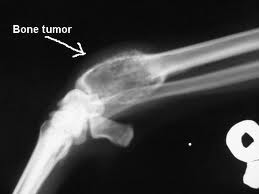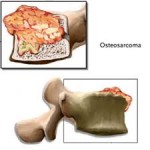In addition to bone cancer, there are various types of benign bone tumors. These include osteoid osteoma, osteoblastoma, osteochondroma, enchondroma, chondromyxoid fibroma, aneurysmal bone cyst, unicameral bone cyst, and giant cell tumor (which has the potential to become malignant). As with other types of benign tumors, these are not cancerous.
There are two other relatively common types of cancer that develop in the bones: lymphoma and multiple myeloma. Lymphoma, a cancer arising from the cells of the immune system, usually begins in the lymph nodes but can begin in the bone. Multiple myeloma begins in the bones, but it is not usually considered a bone tumor because it is a tumor of the bone marrow cells and not of the bone cells.
What are bone cancer symptoms and signs?
The most common symptom of bone tumors is pain. In most cases, the symptoms become gradually more severe with time, including bone pain. Initially, the pain may only be present either at night or with activity. Depending on the growth of the tumor, those affected may have symptoms for weeks, months, or years before seeking medical advice. In some cases, a mass or lump may be felt either on the bone or in the tissues surrounding the bone. This is most common with MFH or fibrosarcoma but can occur with other bone tumors. The bones can become weakened by the tumor and lead to a fracture after little or no trauma or just from standing on the affected bone. This can occur with both benign and malignant tumors. Even benign tumors can spread locally and weaken the surrounding bone. If the tumor compresses the surrounding nerve it can cause pain, numbness, or tingling in the extremities. If the surrounding blood vessels are compressed, it can affect the blood flow to the extremities. Fever, chills, night sweats, and weight loss can occur but are less common. These symptoms are more common after spread of the tumor to other tissues in the body.
How is bone cancer diagnosed?
 The first thing your doctor will do is to take a complete medical history. This will include a review of your past health issues as well as early symptoms and the progression of symptoms currently. It will give your doctor clues as to your diagnosis. Some types of cancer are more common in people if they have close family members who have had that type of cancer. Some types of cancer, specifically lung cancer, are more common in people with a history of smoking. A description of your symptoms can help your doctor identify the possibility of bone cancer from other possible causes. Next, a complete physical examination can help find the cause of your symptoms. This may include testing your muscle strength, sensation to touch, and reflexes. Certain blood tests can be ordered that can help to identify a possible cancer.
The first thing your doctor will do is to take a complete medical history. This will include a review of your past health issues as well as early symptoms and the progression of symptoms currently. It will give your doctor clues as to your diagnosis. Some types of cancer are more common in people if they have close family members who have had that type of cancer. Some types of cancer, specifically lung cancer, are more common in people with a history of smoking. A description of your symptoms can help your doctor identify the possibility of bone cancer from other possible causes. Next, a complete physical examination can help find the cause of your symptoms. This may include testing your muscle strength, sensation to touch, and reflexes. Certain blood tests can be ordered that can help to identify a possible cancer.
Next, your doctor will likely order some imaging studies. Plain X-rays are often ordered first. In some cases, if the cancer is identified very early, it may not show up on plain X-rays. The appearance of a tumor on the X-ray can help determine the type of cancer and whether or not it is benign or malignant. Benign tumors are more likely to have a smooth border while malignant tumors are more likely to have a ragged border on X-ray images. This is because the benign tumors typically grow more slowly and the bone has time to try to surround the tumor with normal bone. Malignant tumors are more likely to grow more quickly, not giving the normal bone a chance to surround the tumor. The X-rays can also be used to identify if a fracture has occurred or if the bone has been weakened and is at risk for a potential fracture.
A CT scan (CAT scan or computed tomography) scan is a more advanced test that can give a cross-sectional picture of your bones. This test gives very good detail of your bones and is better able to identify a possible tumor. It also gives additional information on the size and location of the tumor.
An MRI (magnetic resonance imaging) is another advanced test that can also provide cross sectional imaging of your body. The MRI provides better detail of the soft tissues, including muscles, tendons, ligaments, nerves, and blood vessels than a CT scan.  This test can give better detail on whether or not the bone tumor has broken through the bone and involved the surrounding soft tissues.
This test can give better detail on whether or not the bone tumor has broken through the bone and involved the surrounding soft tissues.
A bone scan is a test that identifies areas of rapidly growing or remodeling bone. The bone scan is often taken of the entire body. This test may be ordered to see if there are any other areas of bone involvement throughout the body. This test is not specific for any specific type of tumor and can be positive with many other conditions including infection, fracture, and arthritis.
If a tumor is identified, your doctor will use all of the information from the history and physical examination along with the laboratory and imaging studies to put together a list of possible causes (differential diagnosis).
Your doctor may then obtain a biopsy sample of the tumor. This involves taking a small sample of the tumor that can be examined in the laboratory by a pathologist (a physician with special training in tissue diagnosis) to determine what kind of tumor it is. The biopsy can be obtained either through a small needle (needle biopsy) or through a small incision (incisional biopsy). The various imaging studies will be used to determine the safest and easiest location from which to obtain the biopsy sample.
